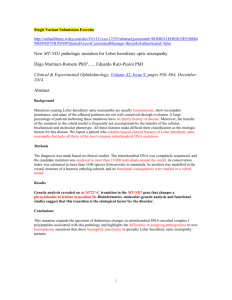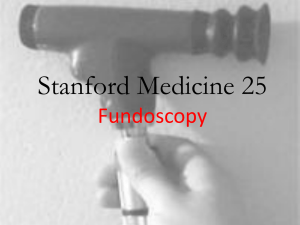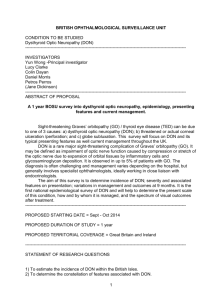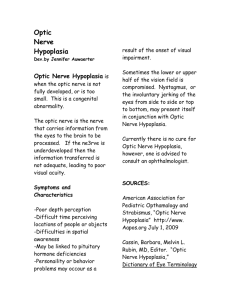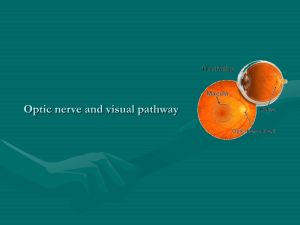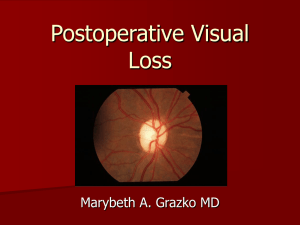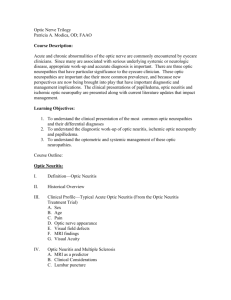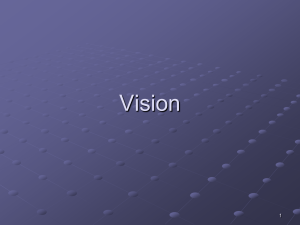Neuro-ophthalmology - Sight Loss and Vision Priority Setting
advertisement
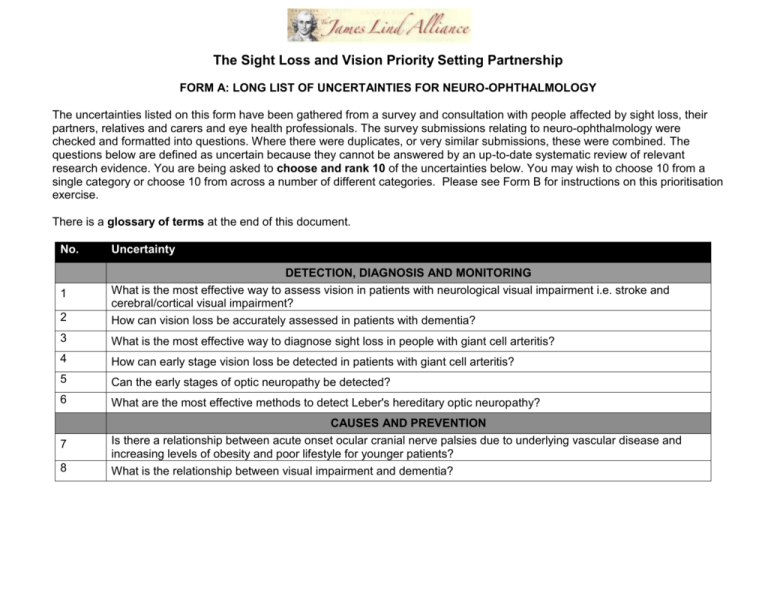
The Sight Loss and Vision Priority Setting Partnership FORM A: LONG LIST OF UNCERTAINTIES FOR NEURO-OPHTHALMOLOGY The uncertainties listed on this form have been gathered from a survey and consultation with people affected by sight loss, their partners, relatives and carers and eye health professionals. The survey submissions relating to neuro-ophthalmology were checked and formatted into questions. Where there were duplicates, or very similar submissions, these were combined. The questions below are defined as uncertain because they cannot be answered by an up-to-date systematic review of relevant research evidence. You are being asked to choose and rank 10 of the uncertainties below. You may wish to choose 10 from a single category or choose 10 from across a number of different categories. Please see Form B for instructions on this prioritisation exercise. There is a glossary of terms at the end of this document. No. Uncertainty 1 2 DETECTION, DIAGNOSIS AND MONITORING What is the most effective way to assess vision in patients with neurological visual impairment i.e. stroke and cerebral/cortical visual impairment? How can vision loss be accurately assessed in patients with dementia? 3 What is the most effective way to diagnose sight loss in people with giant cell arteritis? 4 How can early stage vision loss be detected in patients with giant cell arteritis? 5 Can the early stages of optic neuropathy be detected? 6 What are the most effective methods to detect Leber's hereditary optic neuropathy? 7 CAUSES AND PREVENTION Is there a relationship between acute onset ocular cranial nerve palsies due to underlying vascular disease and increasing levels of obesity and poor lifestyle for younger patients? What is the relationship between visual impairment and dementia? 8 No. Uncertainty 9 What causes vision loss in patients with dementia? 10 Can sight loss due to vascular dementia improve over time? 11 What causes sight loss in giant cell arteritis? 12 17 How can sight loss caused by giant cell arteritis be prevented? What is the cause of differential involvement of blood vessels in giant cell arteritis - why is the eye commonly affected and the kidney is not? Why is there so little consensus on remission and relapses and the impact on vision for people with giant cell arteritis? Can sight loss from giant cell arteritis be caused or exacerbated by infection e.g. shingles, chicken pox? What is the underlying cause of optic nerve damage in optic atrophies such as giant cell arteritis, optic neuritis and other optic neuropathies? How can optic nerve neuropathies be prevented? 18 How can cerebral vision impairment in children be prevented? 19 How can the onset of Leber's hereditary optic neuropathy be prevented? 20 What are the defective genes in Leber's hereditary optic neuropathy? 21 What triggers eyesight loss in some individuals with Leber's hereditary optic neuropathy? 22 Why does eyesight loss not happen until a certain age for people with Leber's hereditary optic neuropathy? 23 Why does Leber's hereditary optic neuropathy cause loss of vision predominantly in men? What is the relationship between Leber's hereditary optic neuropathy and conditions around the body related to premature cell death? Do lifestyle choices (e.g. smoking, alcohol), environmental factors or dietary factors affect the development of Leber's hereditary optic neuropathy? What is the likelihood for children to inherit Leber's hereditary optic neuropathy if only their mother is a carrier of the disease? 13 14 15 16 24 25 26 No. Uncertainty 30 TREATMENT What is the best course of treatment for chronic optic neuritis (CRION) which is steroid-responsive, but which does not seem to respond to a range of immunosuppressants or plasma exchange? What are the optimal treatments/interventions to improve visual function for cerebral vision impairment in children and adults? In children with cerebral vision impairment, do the deficits improve with time, and can the delayed development be accelerated by treatment? Can vision loss due to optic nerve diseases such as giant cell arteritis, optic neuritis and optic atrophy, be restored? 31 What are the most effective treatments for optic neuropathies? 32 Can an alternative treatment to steroids be developed that will treat the sight loss caused by giant cell arteritis? 33 How can electronic glasses restore vision for people with optic neuropathies? 34 36 How can optic neuritis be cured? Can a gene therapy or stem cell treatment be developed for optic nerve diseases e.g. optic neuritis, optic neuropathy and giant cell arteritis? Can treatments be developed for visual field and ocular motility manifestations following stroke? 37 What visual scanning training is best for treatment of homonymous hemianopia? 38 What rehabilitation methods are effective for visual field loss for people with homonymous hemianopia? What rehabilitation methods are most effective for vision loss following brain damage due to stroke, brain injury, cerebral vision impairment, tumours and injury? What are the most effective treatments for Leber's hereditary optic neuropathy? 27 28 29 35 39 40 41 42 Can a gene therapy or stem cell treatment for Leber's hereditary optic neuropathy be developed? What is the effectiveness of hyperbaric oxygen therapy compared to Idebenone treatment for Leber's hereditary optic neuropathy? 43 Are there any dietary factors that can affect the progression of Leber's hereditary optic neuropathy? Glossary of terms: Cerebral/cortical visual impairment: A neurological disorder resulting in vision loss caused by brain damage Genes: The biological code an individual has for a particular trait. Gene therapy: The introduction of genes into the body to treat disease. Giant cell arteritis: Inflammation of large and medium sized blood vessels ("arteries"), with infiltration of small and large blood cells ("giant cell"). An alternative name for this condition is "temporal arteritis" as the blood vessels in the temple area of the head are commonly affected. Homonymous hemianopia: An absence of vision towards one side in each eye. Idebenone: A drug with “antioxidant” properties thought to reduce the formation of free radicals and help mitochondrial energy production thereby reducing cellular damage and vision loss in Leber's hereditary optic neuropathy. Immunosuppressant: A substance that can suppress or prevent an immune response. Leber's hereditary optic neuropathy: A mitochondrially inherited (mother to all offspring) degeneration of retinal ganglion cells that leads to loss of central vision. Optic atrophy/neuropathy: The loss of fibers on the optic nerve. Optic nerve: The nerve which attaches the eyes to the brain. Optic neuritis: The inflammation of the optic nerve which can cause partial or complete visual loss. Plasma exchange: The removal, treatment and return of blood plasma. Polymyalgia rheumatica: Inflammation of large muscles usually in the neck, shoulders and hips. Stem cells: Cells that have the potential to become any type of cell in the body. Steroids: Anti-inflammatory drugs used to treat inflammation.
